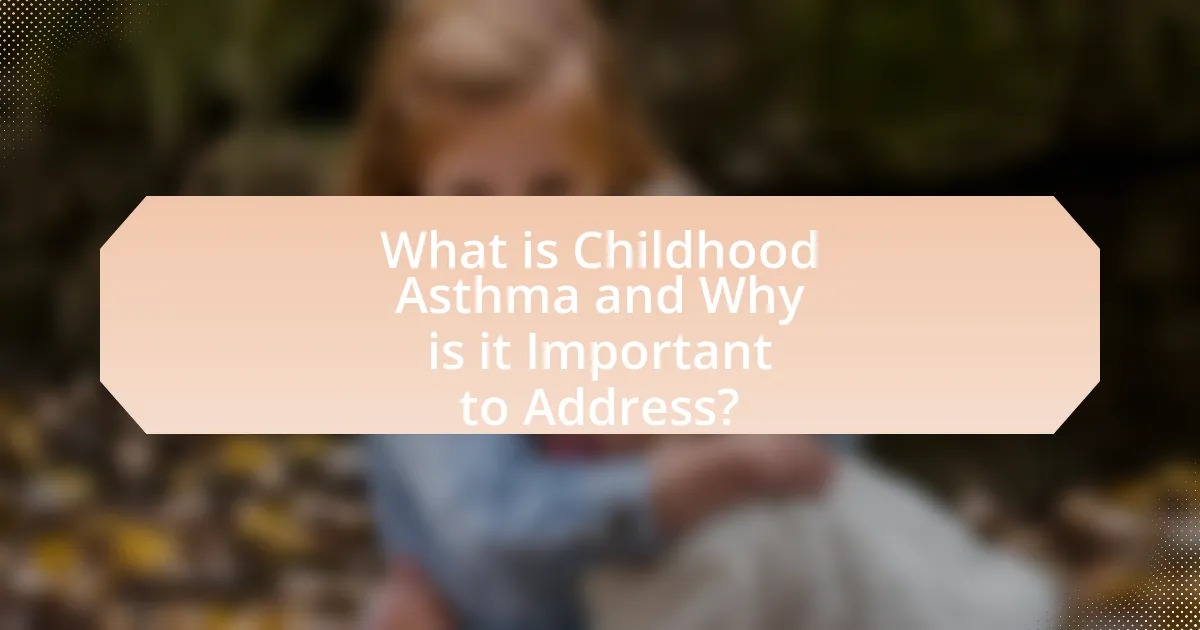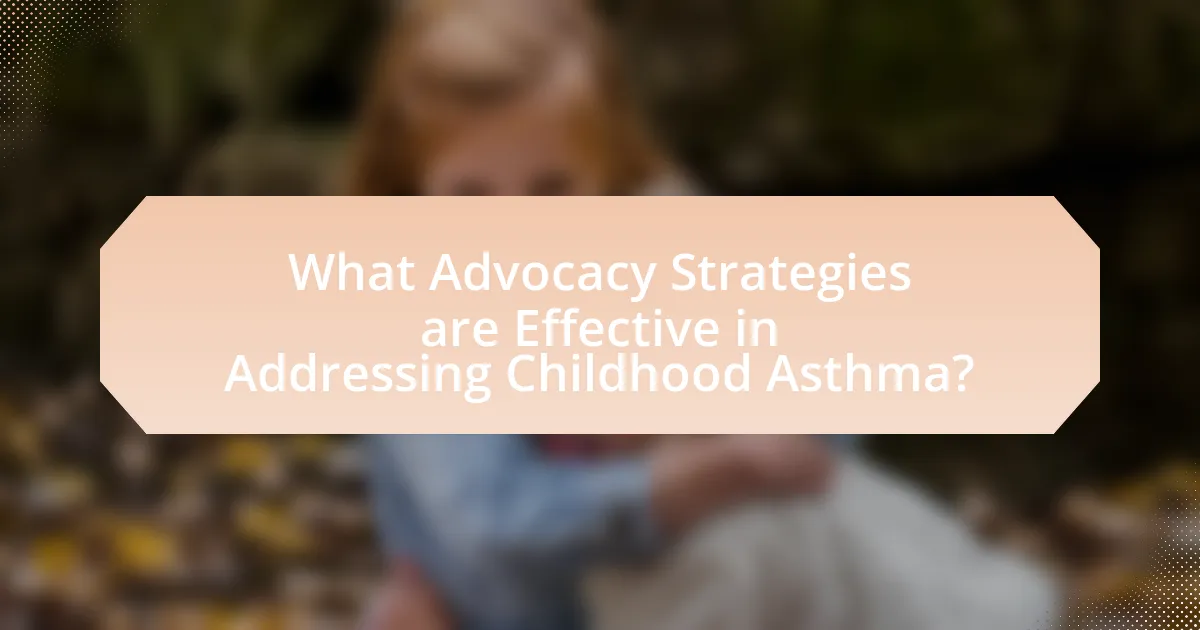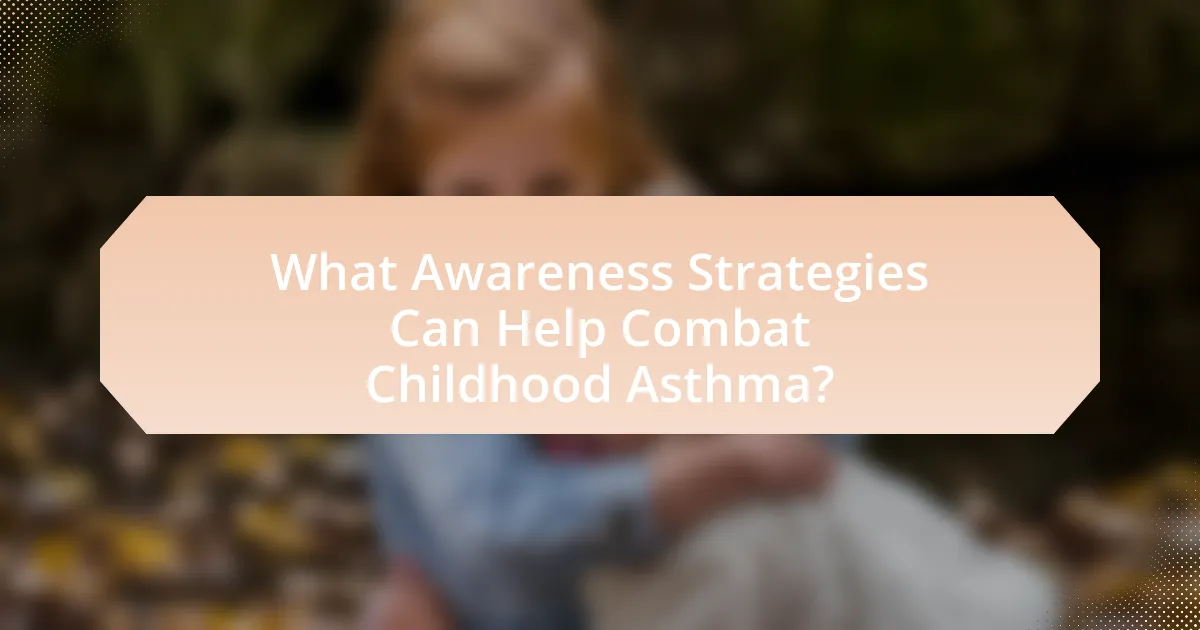Childhood asthma is a prevalent chronic respiratory condition affecting approximately 6 million children in the United States, characterized by airway inflammation and difficulty in breathing. This article addresses the importance of early intervention and effective management strategies to improve health outcomes and reduce the healthcare burden associated with asthma. It explores the impact of asthma on children’s health, development, and daily life, as well as the common symptoms, causes, and triggers. Additionally, it highlights advocacy strategies for parents, caregivers, and healthcare professionals to enhance asthma management and raise awareness within communities, emphasizing the role of education and collaboration in combating this condition.

What is Childhood Asthma and Why is it Important to Address?
Childhood asthma is a chronic respiratory condition characterized by inflammation and narrowing of the airways, leading to difficulty in breathing, wheezing, and coughing. It is crucial to address childhood asthma because it affects approximately 6 million children in the United States, making it one of the most common chronic diseases among this age group. Effective management and intervention can significantly reduce hospitalizations, improve quality of life, and prevent long-term complications associated with uncontrolled asthma. Addressing this condition early can lead to better health outcomes and reduce the overall healthcare burden.
How does Childhood Asthma affect children’s health and development?
Childhood asthma significantly impacts children’s health and development by causing respiratory issues that can lead to missed school days and hinder physical activity. Children with asthma often experience symptoms such as wheezing, coughing, and shortness of breath, which can limit their participation in sports and social activities, affecting their overall physical development. Research indicates that children with asthma are more likely to experience anxiety and depression due to the chronic nature of their condition and the limitations it imposes on their daily lives. Additionally, studies show that asthma can lead to poorer academic performance, as children may struggle to concentrate in class due to fatigue from nighttime symptoms or frequent absences.
What are the common symptoms of Childhood Asthma?
Common symptoms of childhood asthma include wheezing, coughing, shortness of breath, and chest tightness. Wheezing is a high-pitched whistling sound during breathing, often more noticeable during exhalation. Coughing, particularly at night or during physical activity, can indicate airway inflammation. Shortness of breath may occur during routine activities or at rest, while chest tightness can feel like pressure or discomfort. These symptoms are consistent with asthma’s impact on the respiratory system, as confirmed by the American Academy of Pediatrics, which states that asthma affects approximately 6 million children in the United States, highlighting the prevalence and importance of recognizing these symptoms for early intervention.
How does Childhood Asthma impact daily life for children and families?
Childhood asthma significantly impacts daily life for children and families by restricting physical activities and requiring constant management of symptoms. Children with asthma often experience limitations in participating in sports, outdoor play, and other activities due to fear of asthma attacks triggered by exercise or environmental factors. Families must frequently monitor air quality, manage medications, and be prepared for emergencies, which can lead to increased stress and anxiety. According to the Centers for Disease Control and Prevention, asthma affects approximately 6 million children in the United States, highlighting the widespread nature of this issue and its implications for family dynamics and daily routines.
What are the primary causes and triggers of Childhood Asthma?
The primary causes and triggers of childhood asthma include genetic factors, environmental allergens, respiratory infections, and exposure to tobacco smoke. Genetic predisposition plays a significant role, as children with a family history of asthma or allergies are more likely to develop the condition. Environmental allergens such as pollen, dust mites, mold, and pet dander can provoke asthma symptoms in susceptible children. Additionally, viral respiratory infections, particularly during early childhood, are known to increase the risk of asthma development. Exposure to tobacco smoke, both prenatal and postnatal, has been linked to a higher incidence of asthma in children, as it can damage developing lungs and increase sensitivity to allergens.
How do environmental factors contribute to Childhood Asthma?
Environmental factors significantly contribute to childhood asthma by triggering inflammatory responses in the airways. Exposure to allergens such as pollen, mold, pet dander, and dust mites can lead to increased asthma symptoms in children. Additionally, air pollution, including particulate matter and ozone, has been linked to the exacerbation of asthma symptoms, as studies indicate that children living in urban areas with high pollution levels experience more frequent asthma attacks. Furthermore, tobacco smoke exposure, both prenatal and postnatal, is a well-documented risk factor for developing asthma in children, as it can impair lung development and increase airway hyperreactivity.
What role do genetics play in the development of Childhood Asthma?
Genetics significantly influence the development of childhood asthma by predisposing individuals to the condition through inherited traits. Studies indicate that children with a family history of asthma or allergic diseases are at a higher risk of developing asthma themselves, with heritability estimates ranging from 60% to 80%. Specific genetic variations, such as those in the IL4, IL13, and ADAM33 genes, have been associated with increased susceptibility to asthma. Additionally, twin studies have shown a higher concordance rate for asthma in identical twins compared to fraternal twins, further supporting the genetic contribution to the disease.

What Advocacy Strategies are Effective in Addressing Childhood Asthma?
Effective advocacy strategies for addressing childhood asthma include community education, policy advocacy, and collaboration with healthcare providers. Community education initiatives raise awareness about asthma triggers and management, empowering families with knowledge. Policy advocacy focuses on promoting legislation that ensures access to healthcare and environmental protections, such as clean air regulations. Collaboration with healthcare providers enhances the implementation of best practices in asthma management, ensuring children receive appropriate care. Research indicates that comprehensive asthma management programs can reduce emergency room visits by up to 50%, demonstrating the effectiveness of these advocacy strategies in improving health outcomes for children with asthma.
How can parents and caregivers advocate for better asthma management?
Parents and caregivers can advocate for better asthma management by actively engaging with healthcare providers, schools, and community organizations to ensure comprehensive care and support for children with asthma. They should communicate their child’s specific needs and treatment plans to healthcare professionals, participate in school meetings to discuss asthma policies, and collaborate with local advocacy groups to raise awareness about asthma management. Research indicates that effective communication and collaboration can lead to improved health outcomes for children with asthma, as highlighted in studies showing that parental involvement in care plans significantly reduces emergency room visits and hospitalizations.
What resources are available for parents to educate themselves about Childhood Asthma?
Parents can access various resources to educate themselves about Childhood Asthma, including the American Academy of Pediatrics (AAP), which provides guidelines and educational materials on asthma management. The Centers for Disease Control and Prevention (CDC) offers comprehensive information on asthma triggers, symptoms, and treatment options specifically for children. Additionally, the Asthma and Allergy Foundation of America (AAFA) provides resources such as webinars, articles, and support groups tailored for parents. These organizations are credible sources, as they are recognized for their expertise in pediatric health and asthma care.
How can parents collaborate with schools to support children with asthma?
Parents can collaborate with schools to support children with asthma by establishing clear communication regarding the child’s health needs and ensuring that the school has an asthma management plan in place. This collaboration involves parents providing the school with necessary medical documentation, including action plans from healthcare providers, and discussing any specific triggers or symptoms that the child may experience.
Additionally, parents can participate in school meetings to advocate for asthma-friendly policies, such as ensuring that the school environment is free from allergens and that staff are trained to recognize and respond to asthma emergencies. Research indicates that effective communication between parents and schools can significantly improve asthma management and reduce school absenteeism related to asthma attacks.
What role do healthcare professionals play in advocacy for Childhood Asthma?
Healthcare professionals play a critical role in advocacy for childhood asthma by educating families, promoting awareness, and influencing policy changes. They provide essential information about asthma management, including medication adherence and environmental triggers, which empowers parents and caregivers to better manage their children’s condition. Additionally, healthcare professionals often participate in community outreach programs and collaborate with organizations to raise awareness about asthma’s impact on children, thereby fostering a supportive environment. Their involvement in research and policy advocacy helps shape guidelines and funding for asthma care, ensuring that children receive the necessary resources and support for effective management.
How can doctors and nurses improve asthma care for children?
Doctors and nurses can improve asthma care for children by implementing personalized asthma action plans and providing education on medication adherence. Personalized action plans help families understand how to manage asthma symptoms and recognize triggers, which is crucial for effective care. Studies show that children with asthma who have action plans experience fewer hospitalizations and emergency visits, highlighting the importance of tailored management strategies. Additionally, educating families about the correct use of inhalers and the importance of regular follow-ups can significantly enhance asthma control, as proper medication use is linked to improved health outcomes in pediatric asthma patients.
What training is necessary for healthcare providers to effectively support families?
Healthcare providers require training in family-centered care, communication skills, and asthma management to effectively support families dealing with childhood asthma. Family-centered care training equips providers with the skills to engage families as partners in the care process, ensuring that their needs and preferences are prioritized. Communication skills training enhances providers’ abilities to convey complex medical information clearly and empathetically, fostering trust and understanding. Additionally, specialized training in asthma management, including the latest treatment protocols and educational strategies, enables providers to offer tailored support and resources to families, ultimately improving health outcomes.

What Awareness Strategies Can Help Combat Childhood Asthma?
Awareness strategies that can help combat childhood asthma include educational programs for parents and children, community outreach initiatives, and collaboration with healthcare providers. Educational programs, such as those provided by the American Lung Association, inform families about asthma triggers, management techniques, and the importance of medication adherence. Community outreach initiatives, like asthma camps and workshops, foster peer support and provide practical skills for managing asthma. Collaboration with healthcare providers ensures that families receive tailored advice and resources, enhancing overall asthma management. These strategies have been shown to improve asthma control and reduce emergency room visits among children, as evidenced by studies indicating that education and community support significantly lower asthma-related complications.
How can community awareness campaigns raise understanding of Childhood Asthma?
Community awareness campaigns can raise understanding of childhood asthma by providing targeted education and resources to families and caregivers. These campaigns often utilize workshops, informational materials, and social media outreach to disseminate vital information about asthma triggers, management strategies, and the importance of early diagnosis. For instance, the American Lung Association’s “Asthma Basics” program has successfully increased knowledge among parents about asthma management, leading to improved health outcomes for children. Research indicates that communities with active awareness campaigns report higher rates of asthma action plan usage and better adherence to medication, demonstrating the effectiveness of these initiatives in enhancing understanding and management of childhood asthma.
What types of events can be organized to promote awareness of Childhood Asthma?
Various events can be organized to promote awareness of Childhood Asthma, including educational workshops, community health fairs, and school-based awareness programs. Educational workshops can provide parents and caregivers with essential information on asthma management, while community health fairs can offer free screenings and resources. School-based programs can engage children directly, teaching them about asthma triggers and management strategies. According to the Centers for Disease Control and Prevention, asthma affects approximately 6 million children in the United States, highlighting the need for increased awareness and education through such events.
How can social media be utilized to spread awareness about Childhood Asthma?
Social media can be utilized to spread awareness about childhood asthma by creating targeted campaigns that educate parents and caregivers about the condition. These campaigns can include sharing informative posts, infographics, and videos that highlight symptoms, triggers, and management strategies. For instance, the Asthma and Allergy Foundation of America has effectively used platforms like Facebook and Twitter to disseminate educational content, reaching millions of users and increasing awareness about asthma management. Additionally, engaging with community influencers and healthcare professionals on social media can amplify the message, fostering a supportive online community that encourages sharing personal experiences and resources related to childhood asthma.
What educational materials are effective in informing the public about Childhood Asthma?
Effective educational materials for informing the public about Childhood Asthma include brochures, online resources, workshops, and community seminars. Brochures provide concise information on symptoms, triggers, and management strategies, making them accessible for parents and caregivers. Online resources, such as websites from reputable health organizations like the American Lung Association, offer comprehensive guides and interactive tools for understanding asthma. Workshops and community seminars facilitate direct engagement with healthcare professionals, allowing for personalized education and Q&A sessions. Research indicates that community-based education significantly improves asthma management and awareness, as evidenced by a study published in the Journal of Asthma, which found that participants in educational programs reported better understanding and control of their children’s asthma symptoms.
How can schools implement educational programs about asthma management?
Schools can implement educational programs about asthma management by integrating asthma education into the health curriculum and providing training for staff and students. This approach ensures that both educators and students understand asthma triggers, symptoms, and management strategies. Research indicates that comprehensive asthma education can lead to improved self-management skills among students, reducing the frequency of asthma attacks and emergency room visits. For instance, a study published in the Journal of School Health found that schools that incorporated asthma education saw a 20% decrease in asthma-related absenteeism. By utilizing resources from organizations like the American Lung Association, schools can access materials and training programs tailored to effectively educate the school community about asthma management.
What role do non-profit organizations play in providing educational resources?
Non-profit organizations play a crucial role in providing educational resources by developing programs that raise awareness and disseminate information about childhood asthma. These organizations often create educational materials, conduct workshops, and offer training sessions for parents, educators, and healthcare providers to enhance understanding of asthma management. For instance, the American Lung Association provides resources that include guidelines on asthma care and prevention strategies, which are essential for improving health outcomes in children with asthma. By leveraging community outreach and partnerships, non-profits effectively bridge gaps in knowledge and access to information, thereby empowering families and communities to better manage asthma.
What are some practical tips for managing Childhood Asthma effectively?
To manage childhood asthma effectively, parents and caregivers should implement a comprehensive asthma action plan that includes regular monitoring of symptoms and medication adherence. This plan should be developed in consultation with a healthcare provider and tailored to the child’s specific needs. Regular use of a peak flow meter can help track lung function and identify early signs of an asthma attack. Additionally, minimizing exposure to asthma triggers such as allergens, smoke, and pollution is crucial; for instance, keeping the home environment clean and free from dust mites and pet dander can significantly reduce symptoms. According to the Centers for Disease Control and Prevention, effective asthma management can lead to fewer hospital visits and improved quality of life for children with asthma.
How can families create an asthma action plan for their children?
Families can create an asthma action plan for their children by collaborating with healthcare providers to outline specific steps for managing asthma symptoms and emergencies. This plan should include identifying triggers, detailing daily management strategies, and specifying when to seek medical help. According to the National Heart, Lung, and Blood Institute, an effective asthma action plan should be personalized, clearly written, and regularly reviewed to ensure it meets the child’s evolving needs.
What lifestyle changes can help reduce asthma symptoms in children?
Regular physical activity, maintaining a healthy diet, and avoiding allergens can significantly reduce asthma symptoms in children. Engaging in regular exercise helps improve lung function and overall health, while a balanced diet rich in fruits, vegetables, and omega-3 fatty acids can reduce inflammation. Additionally, minimizing exposure to common allergens such as dust mites, pet dander, and pollen through proper cleaning and air filtration can prevent asthma triggers. Studies indicate that children who participate in physical activities and consume a nutritious diet experience fewer asthma attacks and better control of their symptoms.